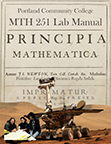Activity 1.1 Velocity
¶Motion is frequently modeled using calculus. A building block for this application is the concept of average velocity. Average velocity is defined to be net displacement divided by elapsed time. More precisely,
Definition 1.1.1. Average Velocity.
If \(p\) is a position function for something moving along a numbered line, then we define the average velocity over the time interval \(\cinterval{t_0}{t_1}\) to be:
Subsection Exercises
According to simplified Newtonian physics, if an object is dropped from an elevation 1 If you encounter an unfamiliar unit of measure while reading this lab manual, see Appendix D. of \(200\) meters (m) and allowed to free fall to the ground, then the elevation of the object is given by the position function
where \(t\) is the amount of time that has passed since the object was dropped. (The “\(200\) m” in the formula represents the elevation from which the object was dropped, and the “\(4.9\) m⁄s2” represents one half of the acceleration due to gravity near the surface of Earth.)
1.
Calculate \(\fe{p}{3\,\mathrm{s}}\) and \(\fe{p}{5\,\mathrm{s}}\text{.}\) Make sure that you include the units specified in the formula for \(\fe{p}{t}\text{,}\) and that you replace \(t\) with, respectively, \(3\) s and \(5\) s. Make sure that you simplify the units, as well as the numerical part of the function value.
2.
Calculate \(\frac{\fe{p}{5\,\text{s}}-\fe{p}{3\,\text{s}}}{{5\,\text{s}}-{3\,\text{s}}}\text{;}\) include units while making the calculation. Note that you already calculated \(\fe{p}{3\,\text{s}}\) and \(\fe{p}{5\,\text{s}}\) in Exercise 1.1.1. What does the result tell you in the context of this problem?
3.
Thus far we have used a formula where every number that appears in the formula comes with its real world unit (\(\fe{p}{t}=200\,\text{m}-\left(4.9\,\sfrac{\text{m}}{\text{s}^2}\right)t^2\)). A formula like this allows you to calculate \(\fe{p}{5\,\text{s}}\) or \(\fe{p}{5\,\text{min}}\) as you please, as long as you track the units and reduce ratios appropriately.
However, all those units in the original formula might distract you from new calculus topics. We could just write \(\fe{p}{t}=200-4.9t^2\text{,}\) but if we do so, we have to specify that \(t\) is in seconds and \(\fe{p}{t}\) is in meters. With this formula, we can calculate something like \(\fe{p}{5}\text{,}\) but we need to recognize that in context, the \(5\) means that \(5\) seconds have passed. And when we arrive at the result, \(\fe{p}{5}=77.5\text{,}\) we need to realize that the position is \(77.5\) meters.
For the remainder of this lab manual, formulas will be written in this second way, without explicit units. Each variable will be specified with what unit it is intended to be measured in. To continue the current block of exercises, we redefine
where \(t\) is in s, and \(\fe{p}{t}\) is in m.
Use Definition 1.1.1 to find a formula for the average velocity of this object over the general time interval \(\cinterval{t_0}{t_1}\text{.}\) The first couple of lines of this process are shown below. Copy these lines onto your paper and continue the simplification process.
Factor \(-4.9\) from the numerator; the remaining factor will factor further.
4.
Check the formula you derived in Exercise 1.1.3 using \(t_0=3\) and \(t_1=5\text{;}\) that is, compare the value generated by the formula to that you found in Exercise 1.1.2.
5.
Now explore some average velocities in tabular form.
Using the formula found in Exercise 1.1.3, replace \(t_0\) with \(3\) but leave \(t_1\) as a variable; simplify the result. Then copy Table 1.1.2 onto your paper and fill in the missing entries.
| \(t_1\) (s) | \(\frac{\fe{p}{t_1}-\fe{p}{3}}{t_1-3}\) (m⁄s) |
| 2.9 | |
| 2.99 | |
| 2.999 | |
| 3.001 | |
| 3.01 | |
| 3.1 |
6.
As the value of \(t_1\) gets closer to \(3\text{,}\) the values in the \(y\)-column of Table 1.1.2 appear to be converging on a single quantity; what is this quantity? What does it mean in the context of this problem?
